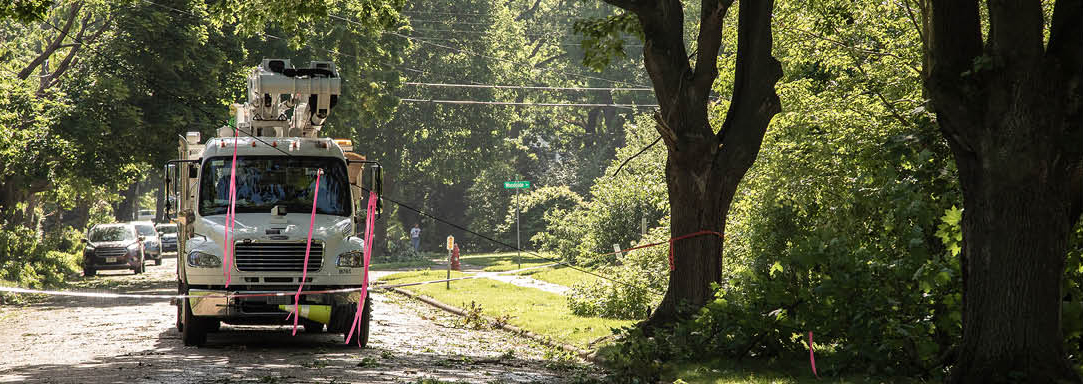
Power Restoration
Ensuring electric reliability is one of MGE's top priorities, and MGE consistently ranks among the top utilities in the country for the fewest outages. We realize, however, that when you lose power, you want to know how quickly your service will be restored. Rest assured we are working as quickly as we safely can to put your power back on. On an average "blue sky day," MGE has historically restored power within 2 hours or less.
All outage restoration follows a five-step process. In small incidents, these steps are often done by a single crew and can be accomplished very quickly. In major outages, however, several parts of the company become involved.
The first step of restoring service is always investigating the situation to understand what we are dealing with. We need to determine the extent of the damage, what repairs are needed and what resources—crews, trucks and equipment—will be required to fix it. In a large outage after a major storm or other emergency with so many situations to investigate, this assessment period may take 24 hours or more.
The second step is to plan and prioritize our restoration process. Every situation is different, but we follow a specific set of guidelines to determine the order of what gets fixed first.
MGE follows this order when restoring power:
- Situations that could endanger public health and safety such as live, downed wires.
- Vital public services—hospitals, police and fire departments, sewer and water facilities—that everyone needs.
- Damage to a transmission line or substation that sends power into the distribution system.
- Main distribution lines that feed the lines serving your neighborhood.
- Overhead or underground lines on an individual street.
- Service wire to a single home or business.
Then we assemble the resources—collect equipment, load the trucks, assign the crews and provide instructions—and deploy them into the field.
Once our crews are in the field, they provide updates to our Distribution Operations Center as they begin the physical restoration process.
After every major event, we review what was done well and what could have been done better so when the next situation arises, we will improve our restoration process.
Power restoration estimates
Our power restoration estimates are the best we can predict with the information we have at the time. Unexpected things happen that can change how quickly we are able to restore power. We work as quickly as is safely possible to restore power. We will update our estimates as new information becomes available.
- The initial estimate of how long it will take MGE to restore power is calculated based on historical restoration data, the time of day and the type of outage reported.
- Once our crews are on-site and able to investigate the situation, they will provide our distribution system operators with a more detailed assessment and an on-site estimate of when your power will be restored.
- Sometimes as the restoration work proceeds, our crews encounter additional problems, the situation is more complex than first predicted or the weather causes additional damage. In these cases, they will communicate with our system operators who will update the estimated restoration times.
Many things can impact restoration times:
- If snow has blocked the streets, snowplow crews will need to clear a path for our trucks, equipment and repair crews.
- When damaged trees and broken branches are tangled with electric lines and broken poles, the power feeding the affected lines must first be shut off so tree-trimming crews can remove enough debris to free the lines and allow them to be repaired.
- If equipment has been damaged, replacements need to be located, loaded and hauled to the site for installation. Replacing poles and transformers takes much longer than just putting a line back up.
- To restore power to individual homes and businesses, all the electrical infrastructure from the power plant to the customers—including transmission lines, substations and distribution lines—must be intact before electricity can flow into the neighborhood.
- It is not safe for our crews to work on tall poles in high winds.
- Making repairs during bitterly cold or extremely hot weather will take longer.
- Continuing rain/sleet/snow/wind can cause additional damage.
- It is more difficult to identify the cause of an outage on underground lines than overhead lines.
- A damaged line in a neighborhood backyard that's not accessible by bucket truck and requires individuals to manually climb poles will take longer to repair than a line along a street.
- If the damage is limited to a major distribution feeder line, service to more people will be restored more quickly with just one repair than if there are a number of smaller outages impacting the same number of customers.
- We give highest priority to situations that threaten public safety, such as downed live wires. We'll make the situation safe first and may not immediately repair it if other locations are higher priority.
- We give higher priority to restoring service for essential health and safety services, such as police and fire stations, hospitals, and municipal water and sewer locations.
- Restoration work will be prioritized for situations that restore service to the largest number of customers most quickly.
- During weekday business hours, MGE is fully staffed to respond quickly, with crews and trucks already working around our service area.
- During nights and weekends, we maintain limited staffing and may require additional crews to be called in from home. It will take longer for them to report to work, load needed equipment and drive to the outage location.
- Non-business hours also may require more time to locate any special equipment needed for the repairs.

